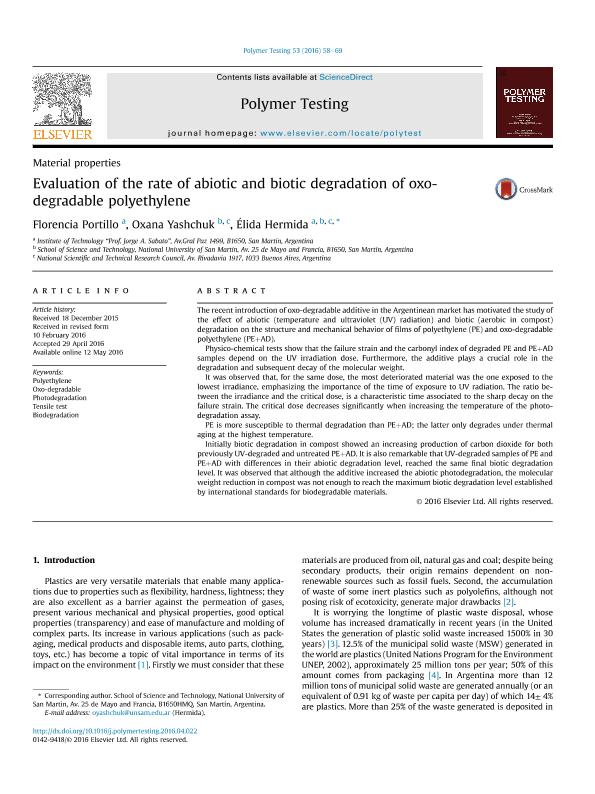Artículo
Evaluation of the rate of abiotic and biotic degradation of oxodegradable polyethylene
Fecha de publicación:
08/2016
Editorial:
Elsevier
Revista:
Polymer Testing
ISSN:
0142-9418
Idioma:
Inglés
Tipo de recurso:
Artículo publicado
Clasificación temática:
Resumen
The recent introduction of oxo-degradable additive in the Argentinean market has motivated the study of the effect of abiotic (temperature and ultraviolet (UV) radiation) and biotic (aerobic in compost) degradation on the structure and mechanical behavior of films of polyethylene (PE) and oxo-degradablepolyethylene (PE+AD).Physico-chemical tests show that the failure strain and the carbonyl index of degraded PE and PE+AD samples depend on the UV irradiation dose. Furthermore, the additive plays a crucial role in the degradation and subsequent decay of the molecular weight.It was observed that, for the same dose, the most deteriorated material was the one exposed to the lowest irradiance, emphasizing the importance of the time of exposure to UV radiation. The ratio between the irradiance and the critical dose, is a characteristic time associated to the sharp decay on the failure strain. The critical dose decreases significantly when increasing the temperature of the photodegradation assay.PE is more susceptible to thermal degradation than PE+AD; the latter only degrades under thermal aging at the highest temperature.Initially biotic degradation in compost showed an increasing production of carbon dioxide for both previously UV-degraded and untreated PE+AD. It is also remarkable that UV-degraded samples of PE and PE+AD with differences in their abiotic degradation level, reached the same final biotic degradation level. It was observed that although the additive increased the abiotic photodegradation, the molecular weight reduction in compost was not enough to reach the maximum biotic degradation level established by international standards for biodegradable materials.
Palabras clave:
Polyethylene
,
Oxo-Degradable
,
Photodegradation
,
Tensile Test
,
Biodegradation
Archivos asociados
Licencia
Identificadores
Colecciones
Articulos(SEDE CENTRAL)
Articulos de SEDE CENTRAL
Articulos de SEDE CENTRAL
Citación
Portillo, Florencia Soledad; Yashchuk, Oxana; Hermida, Elida Beatriz; Evaluation of the rate of abiotic and biotic degradation of oxodegradable polyethylene; Elsevier; Polymer Testing; 53; 8-2016; 58-69
Compartir
Altmétricas




